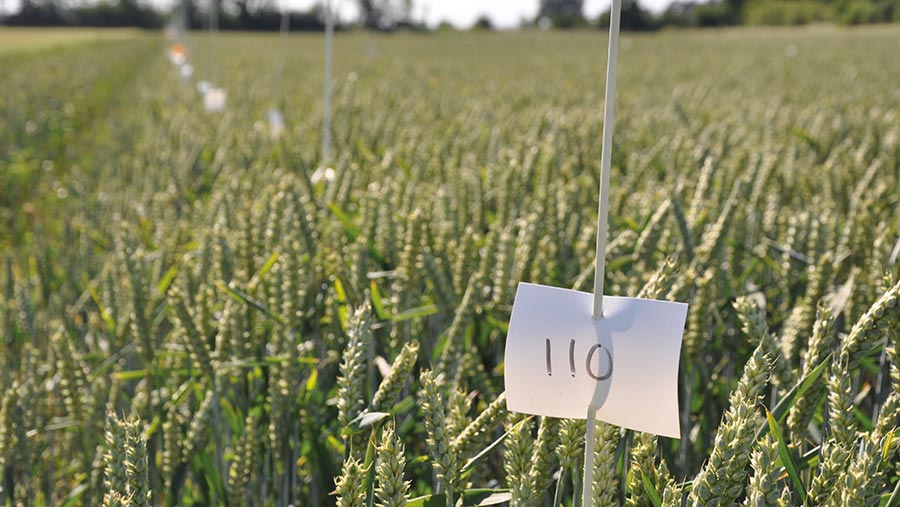How to adapt management to specific winter wheat varieties for spring 2023
 ProCam trial plots © ProCam
ProCam trial plots © ProCam As new varieties arrive to the market, crops are planted over a wide drilling window and disease pressure evolves, tailoring winter wheat management to specific variety needs can help farmers get the most from their crops.
Rising input inflation and a greater focus on sustainable farming practices are triggering growers to cut back on costly fungicide expenditure and opt for varieties with improved disease resistance.
But what happens if these varieties are faster developing and how does this impact spray timing? How should management be adapted when varieties are planted early – for example after this year’s early harvest?
And how does this affect a crop’s ability to withstand disease?
See also: Inset v offset carbon credits: benefits and risks to farmers
Differing characteristics
All wheat varieties differ in agronomic characteristics, with varying development rates and disease-resistance profiles.
This uniquely influences optimum fungicide spray and fertiliser timings. What’s more, drill date, weather and soil type have further impacts.

Paul Gruber, ProCam regional technical manager © ProCam
Paul Gruber, ProCam regional technical manager, notes that winter wheat management is a changing landscape and advises growers to treat what is in front of them and take each season as it comes.
“Attention to detail of specific varieties and targeting leaf layers so growers know when to strike with crop protection products is key.
“If you are growing a range of different varieties on farm, you should not be treating crops at the same time or at the same dose rate,” he says.
Below, he offers guidance on spring management for popular winter wheat cultivars to help growers think strategically and plan ahead for the season.
Extase
Extase is currently the largest area of wheat planted in the UK, thanks to its robust disease resistance. However, last year growers in the eastern counties reported a break down in yellow rust.
“We will know by the spring if this will be the case again, but at the moment it’s a waiting game,” Mr Gruber says.
He continues that Extase is a popular variety and grown across the whole of UK. It is, therefore, exposed to a wide range of fungus strains, making it more likely for resistance to be overcome and disease to take hold.
“If growers decide to leave out a T0 spray, yellow rust can develop very quickly. They can soon find themselves walking down a one-way alley of disease attacks.”
If crops are drilled early, the benefits of greater disease resistance are often lost. Growers should be aware that crops may not be as clean as those drilled later.
This is because septoria thrives in a mild autumn, so having a larger leaf canopy exposed to infection for a longer time period will increase disease pressure.
As the crop is relatively fast developing, it is one of the first varieties to require a plant growth regulator and will often reach the key growth stages earlier than other varieties.
In fact, trials showed Extase reached the T1 timing eight days earlier than other mainstay varieties.
However, Extase only has a 3 for eyespot and observations from ProCam trial plots in Yorkshire revealed a particularly prominent issue in untreated plots when crops were drilled early.
Zyatt
Zyatt was the first variety last season to break down to yellow rust, notes Mr Gruber.
“It was really affected, requiring a high-rate fungicide dose to help combat the disease, which was often too late. T0 intervention is essential to manage the disease.”
There is very little space to manoeuvre with this crop, so spray timings should be prioritised over varieties such as Extase, but only if the growth stage requirements are met.
Zyatt is much slower developing than most varieties such as Graham and considerably slower than that of Extase, so monitor crops closely.
Gleam and Graham
These versatile “old favourite” varieties offer growers a reliable choice, but rust tends to be the pair’s biggest disease threat.
For Gleam, yellow rust is its downfall. A T0 spray is usually required of an azole, partnered perhaps with a rust active strobilurin. “If up against it, both actives may be an option as firefighting yellow rust is not an option.”
Graham, on the other hand, offers good yellow rust resistance but its downfall is brown rust which hits later in the season. “Focusing on the flagleaf and T3 earwash timings should be a main consideration.”
Skyfall
This milling wheat is often denoted as a high-risk, high-input crop, but if managed correctly offers good returns.
Compared with Extase it offers a good eyespot rating of 6, which makes up for its poorer yellow rust and septoria traits.
“It certainly needs attention to detail with spray timings, as this is one of the dirtiest varieties on the recommended list.”
Skyscraper
Standing power is poor in Skyscraper as the stem can get quite leggy. An appropriate plant growth regulator dose is therefore required.
“It doesn’t have the best septoria rating, but it offers good yellow rust resistance ,” highlights Mr Gruber.
Crusoe
In Mr Gruber’s opinion, Crusoe is the most reliable option to obtain the protein million standard, making it a safe bet for milling producers. He notes that brown rust is the disease to look out for in this variety.
New varieties Champion, Bairstow and Dawsum
Potential looks good for new varieties Champion, Bairstow and Dawsum.
Champion is set to take a large chunk of the market going forward, as with its yellow rust resistance of 8, the variety appears on paper to be rather “bomb proof”.
“However, we know how quickly varieties can crumble,” says Paul Gruber, ProCam regional technical manager.
“Champion’s eyespot rating of 4 is its Achilles heel and its specific weights are particularly low, so keeping the canopy as green as possible later on in the season is important.”
Similarly, Bairstow has attracted lots of attention but it is not as clean as Champion.
With Dawsum’s yellow rust rating of 9, Mr Gruber is nervous:
“High ratings usually suggest a single-site resistance that can be quickly overcome. Having said that, results looks promising so far.
“It’s main downfall is that it does not offer wheat orange blossom midge resistance, which most other varieties on the recommended list do.”
Nitrogen
Yields were better than expected this harvest, despite fertiliser cutbacks.
Paul Gruber, ProCam regional technical manager, highlights that one year’s worth of results should be taken with a pinch of salt.
“Last year’s dry winter from 2021 into 2022 saw a high amount of residual nitrogen kicking about in soils. Together with the almost perfect grain-fill period, yields and quality were good.”
Will this be replicated this year? Perhaps not, as soil nitrogen reserves are now depleted. Growers remain cautious as fertiliser prices persist at record highs, so yields may take a hit.

